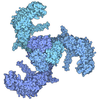+ Open data
Open data
- Basic information
Basic information
| Entry | Database: PDB / ID: 9mek | ||||||||||||||||||||||||
|---|---|---|---|---|---|---|---|---|---|---|---|---|---|---|---|---|---|---|---|---|---|---|---|---|---|
| Title | Structure of the human TWIK-2 potassium channel | ||||||||||||||||||||||||
 Components Components | Potassium channel subfamily K member 6 | ||||||||||||||||||||||||
 Keywords Keywords | MEMBRANE PROTEIN / Two-pore potassium channel K2P6 TWIK2 K2P channel | ||||||||||||||||||||||||
| Function / homology |  Function and homology information Function and homology informationregulation of lysosome size / Tandem of pore domain in a weak inwardly rectifying K+ channels (TWIK) / Phase 4 - resting membrane potential / potassium ion leak channel activity / regulation of resting membrane potential / inward rectifier potassium channel activity / negative regulation of systemic arterial blood pressure / outward rectifier potassium channel activity / positive regulation of NLRP3 inflammasome complex assembly / potassium channel activity ...regulation of lysosome size / Tandem of pore domain in a weak inwardly rectifying K+ channels (TWIK) / Phase 4 - resting membrane potential / potassium ion leak channel activity / regulation of resting membrane potential / inward rectifier potassium channel activity / negative regulation of systemic arterial blood pressure / outward rectifier potassium channel activity / positive regulation of NLRP3 inflammasome complex assembly / potassium channel activity / voltage-gated potassium channel complex / potassium ion transmembrane transport / potassium ion transport / late endosome membrane / lysosomal membrane / metal ion binding / plasma membrane Similarity search - Function | ||||||||||||||||||||||||
| Biological species |  Homo sapiens (human) Homo sapiens (human) | ||||||||||||||||||||||||
| Method | ELECTRON MICROSCOPY / single particle reconstruction / cryo EM / Resolution: 2.85 Å | ||||||||||||||||||||||||
 Authors Authors | Khanra, N.K. / Long, S.B. | ||||||||||||||||||||||||
| Funding support |  United States, 1items United States, 1items
| ||||||||||||||||||||||||
 Citation Citation |  Journal: Proc Natl Acad Sci U S A / Year: 2025 Journal: Proc Natl Acad Sci U S A / Year: 2025Title: Structure of the human TWIK-2 potassium channel and its inhibition by pimozide. Authors: Nandish K Khanra / Chongyuan Wang / Bryce D Delgado / Stephen B Long /  Abstract: The potassium channel TWIK-2 is crucial for ATP-induced activation of the NLRP3 inflammasome in macrophages. The channel is a member of the two-pore domain potassium (K2P) channel superfamily and an ...The potassium channel TWIK-2 is crucial for ATP-induced activation of the NLRP3 inflammasome in macrophages. The channel is a member of the two-pore domain potassium (K2P) channel superfamily and an emerging therapeutic target to mitigate severe inflammatory injury involving NLRP3 activation. We report the cryo-EM structure of human TWIK-2. In comparison to other K2P channels, the structure reveals an unusual "up" conformation of Tyr111 in the selectivity filter and a resulting SF1-P1 pocket behind the filter. Density for acyl chains is present in fenestrations within the transmembrane region that connects the central cavity of the pore to the lipid membrane. Despite its importance as a drug target, limited pharmacological tools are available for TWIK-2. A previous study suggested that the FDA-approved small molecule pimozide might inhibit TWIK-2. Using a reconstituted system, we show that pimozide directly inhibits the channel and we determine a cryo-EM structure of a complex with the drug. Pimozide displaces the acyl chains within the fenestrations and binds below the selectivity filter where it would impede ion permeation. The drug may access its binding site by lateral diffusion in the membrane, suggesting that other hydrophobic small molecules could have utility for inhibiting TWIK-2. The work defines the structure of TWIK-2 and provides a structural foundation for development of more specific inhibitors with potential utility as anti-inflammatory drugs. | ||||||||||||||||||||||||
| History |
|
- Structure visualization
Structure visualization
| Structure viewer | Molecule:  Molmil Molmil Jmol/JSmol Jmol/JSmol |
|---|
- Downloads & links
Downloads & links
- Download
Download
| PDBx/mmCIF format |  9mek.cif.gz 9mek.cif.gz | 102.5 KB | Display |  PDBx/mmCIF format PDBx/mmCIF format |
|---|---|---|---|---|
| PDB format |  pdb9mek.ent.gz pdb9mek.ent.gz | 76.4 KB | Display |  PDB format PDB format |
| PDBx/mmJSON format |  9mek.json.gz 9mek.json.gz | Tree view |  PDBx/mmJSON format PDBx/mmJSON format | |
| Others |  Other downloads Other downloads |
-Validation report
| Arichive directory |  https://data.pdbj.org/pub/pdb/validation_reports/me/9mek https://data.pdbj.org/pub/pdb/validation_reports/me/9mek ftp://data.pdbj.org/pub/pdb/validation_reports/me/9mek ftp://data.pdbj.org/pub/pdb/validation_reports/me/9mek | HTTPS FTP |
|---|
-Related structure data
| Related structure data |  48216MC  9melC M: map data used to model this data C: citing same article ( |
|---|---|
| Similar structure data | Similarity search - Function & homology  F&H Search F&H Search |
- Links
Links
- Assembly
Assembly
| Deposited unit | 
|
|---|---|
| 1 |
|
- Components
Components
| #1: Protein | Mass: 33775.113 Da / Num. of mol.: 2 Source method: isolated from a genetically manipulated source Source: (gene. exp.)  Homo sapiens (human) / Gene: KCNK6, TOSS, TWIK2 / Production host: Homo sapiens (human) / Gene: KCNK6, TOSS, TWIK2 / Production host:  Homo sapiens (human) / References: UniProt: Q9Y257 Homo sapiens (human) / References: UniProt: Q9Y257#2: Chemical | ChemComp-K / #3: Chemical | Has ligand of interest | Y | Has protein modification | Y | |
|---|
-Experimental details
-Experiment
| Experiment | Method: ELECTRON MICROSCOPY |
|---|---|
| EM experiment | Aggregation state: PARTICLE / 3D reconstruction method: single particle reconstruction |
- Sample preparation
Sample preparation
| Component | Name: TWIK-2 / Type: COMPLEX / Details: human TWIK-2 potassium channel / Entity ID: #1 / Source: RECOMBINANT | ||||||||||||||||||||||||||||||
|---|---|---|---|---|---|---|---|---|---|---|---|---|---|---|---|---|---|---|---|---|---|---|---|---|---|---|---|---|---|---|---|
| Molecular weight | Value: 0.03374728 MDa / Experimental value: NO | ||||||||||||||||||||||||||||||
| Source (natural) | Organism:  Homo sapiens (human) Homo sapiens (human) | ||||||||||||||||||||||||||||||
| Source (recombinant) | Organism:  Homo sapiens (human) Homo sapiens (human) | ||||||||||||||||||||||||||||||
| Buffer solution | pH: 7.5 Details: 20 mM HEPES, 150 mM KCl, pH 7.5, 0.0025 % LMNG, 0.00025 % CHS, 0.000825 % GDN | ||||||||||||||||||||||||||||||
| Buffer component |
| ||||||||||||||||||||||||||||||
| Specimen | Conc.: 6 mg/ml / Embedding applied: NO / Shadowing applied: NO / Staining applied: NO / Vitrification applied: YES / Details: Monodisperse recombinantly purified TWIK2 | ||||||||||||||||||||||||||||||
| Specimen support | Grid material: GOLD / Grid mesh size: 400 divisions/in. / Grid type: Quantifoil R1.2/1.3 | ||||||||||||||||||||||||||||||
| Vitrification | Instrument: FEI VITROBOT MARK IV / Cryogen name: ETHANE / Humidity: 90 % / Chamber temperature: 277.15 K / Details: 3.5 uL sample, blot time = 3.0 sec, blot force = 0 |
- Electron microscopy imaging
Electron microscopy imaging
| Experimental equipment |  Model: Titan Krios / Image courtesy: FEI Company |
|---|---|
| Microscopy | Model: TFS KRIOS |
| Electron gun | Electron source:  FIELD EMISSION GUN / Accelerating voltage: 300 kV / Illumination mode: FLOOD BEAM FIELD EMISSION GUN / Accelerating voltage: 300 kV / Illumination mode: FLOOD BEAM |
| Electron lens | Mode: BRIGHT FIELD / Nominal magnification: 165000 X / Nominal defocus max: 2000 nm / Nominal defocus min: 1000 nm / Cs: 2.7 mm / C2 aperture diameter: 50 µm / Alignment procedure: ZEMLIN TABLEAU |
| Specimen holder | Cryogen: NITROGEN / Specimen holder model: FEI TITAN KRIOS AUTOGRID HOLDER |
| Image recording | Electron dose: 60.76 e/Å2 / Film or detector model: TFS FALCON 4i (4k x 4k) |
| EM imaging optics | Energyfilter name: TFS Selectris X / Energyfilter slit width: 10 eV |
- Processing
Processing
| EM software |
| ||||||||||||
|---|---|---|---|---|---|---|---|---|---|---|---|---|---|
| CTF correction | Type: PHASE FLIPPING AND AMPLITUDE CORRECTION | ||||||||||||
| Particle selection | Num. of particles selected: 22020573 | ||||||||||||
| Symmetry | Point symmetry: C2 (2 fold cyclic) | ||||||||||||
| 3D reconstruction | Resolution: 2.85 Å / Resolution method: FSC 0.143 CUT-OFF / Num. of particles: 131053 / Symmetry type: POINT | ||||||||||||
| Atomic model building | B value: 89.3 |
 Movie
Movie Controller
Controller




 PDBj
PDBj





